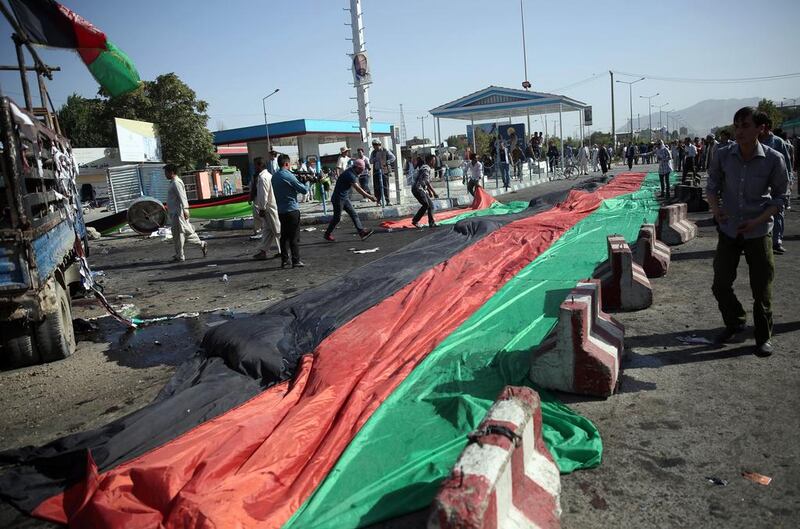KABUL // Abdul Ghafoor Mandegar sat under a tree, sheltering from the Sun in a packed square close to the centre of Kabul. He was one of thousands of young social activists who gathered to demonstrate against the government.
After resting and eating lunch, Mr Mandegar rose to his feet and began to walk from the protest camp, surveying the scene with pride.
He and his friends had marched for hours through the west of the city that morning, July 23, waving flags and carrying banners. Then, at approximately 2.30pm, the suicide bombers struck.
“Suddenly the explosion happened. I fell down with the sound, then tried to escape,” he said. “But when I tried to stand up I understood I was injured.”
A piece of shrapnel had torn into Mr Mandegar’s right leg and three pieces were lodged into his left leg. There was chaos all around him as bodies littered the road and men and women staggered through the debris, their clothes bloodied and torn.
The attack was the first of its kind carried out by ISIL in Kabul, heralding the arrival of a threat that had been brewing for more than a year. At least 80 people were killed and more than 200 wounded.
For many Afghans, including survivors, the events of July 23 will go down as the moment they lost faith in the government.
Plagued by corruption and infighting over whether or not to hold a parliamentary election this autumn, officials were struggling to cope with the Taliban-led insurgency when the bombers struck.
Now they are being accused of exploiting the danger posed by ISIL to distract the public from the even bigger problems the country faces. The anger among civilians on Kabul’s streets could yet prove harder to contain than the fighters of the militant group.
Mr Mandegar spent eight days in hospital and, as a result of his injuries, the 25-year-old walks with the aid of a crutch.
“I think the government is unable to keep the nation, and particularly protests and civil society gatherings, secure,” he said. “In that sense, I think we do not have a government.”
The protesters targeted last month were mostly from Afghanistan’s Hazara community, an ethnic minority which is predominantly Shiite.
They had gathered to demand that plans for a lucrative transnational electricity project be rerouted through Bamiyan province, their heartland in the centre of the country.
The government, however, has already looked into the issue and is only prepared to build a smaller electricity line in the area, sparking allegations of discrimination.
At least two suicide bombers were involved in the attack. One was shot by security forces. The interior ministry also claimed a third bomber failed to detonate his device. He was presumed to be at large.
Although support for ISIL is hard to find in most of Afghanistan, the group’s presence on the battlefield continues to sow discord among fellow insurgents, politicians and the wider public.
Those killed on July 23 included Mohammed Hanif, an engineering student from Daykundi province. Aged 27 and recently married, he was typical of the large number of well-educated young men who participated in the protest.
His brother, Mohammed Arif Rasa, said he was not killed by the explosion but by shots fired from the police, with one bullet hitting him in his upper right leg and another hitting him in the ribs.
Rather than acting in panic, he claimed the security forces targeted the demonstrators in an effort to deter them from holding further rallies.
“It wasn’t because the protest turned violent, it was because of a government conspiracy,” Mr Rasa said.
In the aftermath of the attack, the Afghan president, Ashraf Ghani, blamed the bloodshed on “opportunist terrorists” and defended people’s right to protest peacefully. He said the casualties included a number of security personnel.
Persecuted under the Taliban regime that was overthrown in 2001, the Hazara community has overwhelmingly supported the US-backed governments that have held power since then. But even before the attack there were signs that was beginning to change.
In November 2015, thousands of protesters marched through Kabul after seven Hazara civilians, including two women and a girl, were murdered by insurgents in the south of the country.
In May this year, another huge demonstration took place against the planned route of the electricity project.
Mr Rasa said political leaders from the Hazara community have “sold the blood of their educated Hazara youth” and described ISIL as “a game” being played by the government to further its agenda.
The extremist group’s attempts to establish a foothold in Afghanistan have produced mixed results since it first openly emerged in the country in early 2015.
ISIL’s biggest gains came in the eastern province of Nangarhar, the home of the July 23 bombers, where defectors from the Afghan and Pakistani Taliban helped implement its radical interpretation of Islamic law across a handful of districts.
A recent Afghan-US operation in Nangarhar, however, has killed about 300 ISIL fighters, according to the commander of Nato forces in the country, Gen John Nicholson. Among the dead were ISIL’s leader for Afghanistan and Pakistan, Hafiz Saeed Khan.
Whether or not the operation will ease the pressure on President Ghani remains to be seen. He has predicted victory over ISIL before, confidently telling MPs in March that “Afghanistan will be their graveyard.”
*Chris Sands contributed to this story from the UK.





